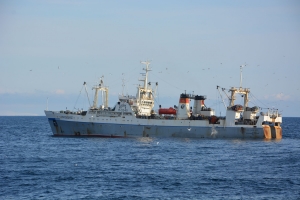
One of the largest-scale Russian fisheries - pollock fishery in the Sea of Okhotsk - was in process from January 01 to March 31 in the northern part of the Sea of Okhotsk within West Kamchatka (61.05.2) and Kamchatka-Kuril (61.05.4) sub-zones and from January 01 to April 09 in the North Sea of Okhotsk sub-zone (61.05.1).
The specialists of Far Eastern fishery research institutes and, in particular, FSBSI KamchatNIRO traditionally provided active input to its information support. Observers from several institutes had been working onboard fishing vessels virtually since the very first days of the fishery: TINRO-Center – 12 persons, KamchatNIRO – 3, MagadanNIRO – 1. This fishing season’s results were record-high in terms of the total number of observers (16 persons totally on mid-water trawlers), processed and analyzed fishing operations (over 1,000), biological tests on pollock and by-catch species (more than 200,000 individuals).
Huge massive of fishing and biological statistical information will be further processed and thoroughly analyzed but some results of the 2017 fishing season can be summed up already now. Same as in 2016, pollock TAC in 2017 in sub-zone 61.05.1 is 348.0 thsd tons, 61.05.2 — 348.0 thsd tons, 61.05.4 – 270.7 thsd tons. Same as in 2010–2016, pollock fishery in sub-zones 61.05.2 and 61.05.4 in 2017 was using a common TAC for both sub-zones equal to 618.7 thsd tons.
According to Vessel Daily Report (VDR) data from the Industry Monitoring System (IMS) of the Federal Fisheries Agency, 179 catching vessels of various types (172 ones in 2016) belonging to 70 Far Eastern companies were engaged in the target pollock trawl fishery in the 2017 fishing season.
Pollock catch by pelagic trawls harvested in a commercial fishery mode in the RF EEZ (target fishery) by all vessels has totaled roughly 823.3 thsd tons by 10 April 2017 which is more than a year ago (766.8 thsd tons). Another 35.7 thsd tons (36.2 thsd tons in 2016) was produced by other fisheries, primarily Danish seine fishery off West Kamchatka. Total pollock catch in Season A was 859.0 thsd tons and TAC use percentage was 88.9%. In the last year, fishing season in the North Sea of Okhotsk sub-zone came to an end 9 days earlier. This circumstance partly explains why catch was higher in this year both in absolute and relative terms (802.7 thsd tons or 83.1% of TAC in 2016).
In general, as the number of catchers and their fishing efforts was increasing, total daily pollock catch in the northern part of the Sea of Okhotsk during the 2017 fishing season was gradually rising: from 1.47 thsd tons in early January to 11.0 thsd tons at the end of that month. It was remaining at roughly the same level till the end of the first ten-day period of February and then abruptly fell almost two times in the second ten-day period of that month, obviously due to bad weather conditions. By the end of February, daily catch recovered to its level in January and again abruptly fell in early March due to same reason. From the second ten-day period of March and till the month’s end, catches were steadily high and averaged at 12.6 thsd tons/day.
By data of KamchatNIRO observers directly from fishing areas, fish length varied from 29 to 54 cm in the target pollock trawl fishery in January 2017 in the Kamchatka-Kuril sub-zone – main fishing area in this month, with size groups of 40–43 cm dominating (51.8%) and average length being 41.6 cm, the majority of such individuals belonging to the 2011 year class. Mean percentage of individuals under commercial size was 9.2%.
One month later, pollock size distribution in catches in sub-zone 61.05.4 virtually did not change. In sub-zone 61.05.2, fish length varied in the range of 27 to 54 cm, the bulk of catch being size groups of 38–41 cm (56.3%) of the strong year-class born in 2011. Mean length was 39.5 cm. In March, fish length in sub-zone 61.05.1 varied from 27 to 57 cm, with 7-8-old individuals 42–46 cm long dominating (71.2%). Mean length was 43.5 cm. In the West Kamchatka sub-zone, pollock size distribution in catches virtually did not change compared with February.
In summary of the above said, we can state that this year’s fishing season generally confirmed scientists’ opinion that the current status of the North Sea of Okhotsk pollock stock is quite favorable (above average). Obvious evidence of that is catch volumes, quantitative and qualitative composition of pollock in commercial catches. This fishing season’s differences from the last year’s one, highlighted in this overview, are explained largely by hydrological, thermal and ice particular features in this year which were reflected in the timing of spawners arrival to their spawning grounds, distribution of commercial aggregations of pollock and, accordingly, distribution of catching flotillas by fishing areas.
Full text of KamchatNIRO report in English is available in the Publications.
The original text in Russian is available at the KamchatNIRO website by the following link: http://www.kamniro.ru/presscenter/obzory_promysla/promysel/itogi_ohotomorskoj_mintaevoj_putiny_2017_g_vzglyad_specialistov_kamchatniro .
